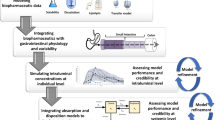Abstract
Purpose. The in vivo hepatic extraction ratio of cynomolgus monkeys was correlated with the corresponding in vitro extraction ratios that were determined in monkey microsomal incubations.
Method. For compounds that are eliminated mainly through liver phase I metabolism, the extraction ratio calculated from liver microsomal stability studies should correlate with their in vivo hepatic extraction ratios and also with their oral bioavailability in monkey. We used both well-stirred and parallel tube models of intrinsic clearance for the correlation. We also calculated extraction ratios for compounds within a given therapeutic area from fraction absorbed values that were estimated from the Caco-2 absorption model.
Result. The present data show that in vitro extraction ratios in monkey microsomes are predictive of the in vivo hepatic extraction ratios in monkeys. All compounds with high extraction ratio (>70%) in vivo were successfully classified as high-extraction-ratio compounds based on the in vitro monkey microsomal stability data. From the results of this study, it appears that the parallel tube model provided a slightly better classification than the well-stirred model.
Conclusions. The present method appears to be a valuable tool to rapidly screen and prioritize compounds with respect to liver first-pass metabolism in monkeys at an early phase of drug discovery.
Similar content being viewed by others
REFERENCES
R. S. Obach, J. G. Baxter, J. G. Listonx, B. M. Silber, B. C. Jones, F. MacIntyre, D. J. Rance, and P. Wastall. The prediction of human pharmacolinetic parameters from preclinical and in vitro metabolism data. J.Pharmacol.Exp.Ther. 283:46-58 (1997).
G. Schneider, P. Coassolo, and T. Lave. Combiningin vitro and in vivo pharmacokinetic data for prediction of hepatic drug clearance in humans by artificial neural networks and multivariate statistical techniques. J.Med.Chem. 42:5072-5076 (1999).
K. Ito, I. Iwatsubo, S. Kanamitsu, Y. Nakajima, and Y. Sugiyama. Quantitative prediction of in vivo drug clearance and drug interactions from in vitro data on metabolism, together with binding and transport. Annu.Rev.Pharmacol.Toxicol. 38:461-499 (1998).
R. S. Obach. Prediction of human clearance of twenty-nine drugs from hepatic microsomal intrinsic clearance data: an examination of in vitro half-life approach and nonspecific binding to microsomes. Drug Metab.Dispos. 27:1350-1359 (1999).
T. Lavé, P. Coassolo, and B. Reigner. Prediction of hepatic metabolic clearance based on interspecies allometric scaling techniques and in vitro-in vivo correlations. Clin.Pharmacokinet. 36:211-231 (1999).
A. Rane, G. R. Wilkinson, and D. G. Shand. Prediction of hepatic extraction ratio from in vitro measurement of intrinsic clearance. J.Pharmacol.Exp.Ther. 200:420-424 (1977).
T. Lavé, S. Dupin, C. Schmitt, B. Valles, G. Ubeaud, R. C. Chou, D. Jaeck, and P. Coassolo. The use of human hepatocytes to select compounds based on their expected hepatic extraction ratios in humans. Pharm.Res. 14:152-155 (1997).
J. B. Houston and D. J. Carlile. Prediction of hepatic clearance from microsomes, hepatocytes, and liver slices. Drug Metab.Rev. 29:891-922 (1997).
J. Zuegge, G. Schneider, P. Coassolo, and T. Lavé. Prediction of hepatic metabolic clearance, a comparison and assessment of prediction models. Clin.Pharmacokinet. 40:553-563 (2001).
Y. Naritomi, S. Terashita, S. Kimura, A. Suzuki, A. Kagayama, and Y. Sugiyama. Prediction of human hepatic clearance from in vivo animal experiments and in vitro metabolic studies with liver microsomes from animal and humans. Drug Metab.Dispos. 29:1316-1324 (2001).
T. Lavé, S. Dupin, C. Schmitt, R. C. Chou, D. Jaeck, and P. Coassolo. Integration of in vitro data into allometric scaling to predict hepatic metabolic clearance in man: application to 10 extensively metabolized drugs. J.Pharm.Sci. 86:584-590 (1997).
G. Krishna, K. Chen, C. Lin, and A. Nomeir. Permeability of lipophilic compounds in drug discovery using in-vitro human absorption model, Caco-2. Int.J.Pharmaceut. 222:77-89 (2001).
W. Rubas, N. Jezyk, and G. M. Grass. Comparison of the permeability characteristics of a human colonic epithelial (Caco-2) cell line to colon of rabbit, monkey, and dog intestine and human drug absorption. Pharm.Res. 10:113-118 (1993).
J. B. Houston. Utility of in vitro drug metabolism data in predicting in vivo metabolic clearance. Biochem.Pharmacol. 47:1469-1479 (1994).
J. Oravcová, B. Böhs, and W. Lindner. Drug-protein binding studies: new trends in analytical and experimental methodology. J.Chrom.B 677:1-28 (1996).
Author information
Authors and Affiliations
Corresponding author
Rights and permissions
About this article
Cite this article
Lau, Y.Y., Krishna, G., Yumibe, N.P. et al. The Use of in Vitro Metabolic Stability for Rapid Selection of Compounds in Early Discovery Based on Their Expected Hepatic Extraction Ratios. Pharm Res 19, 1606–1610 (2002). https://doi.org/10.1023/A:1020765025857
Issue Date:
DOI: https://doi.org/10.1023/A:1020765025857




